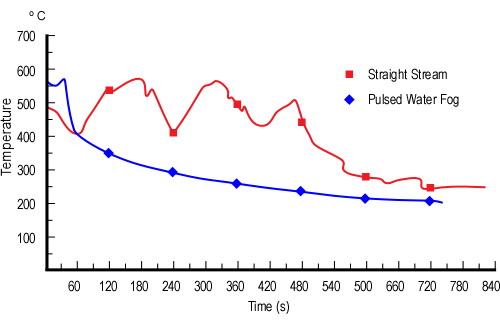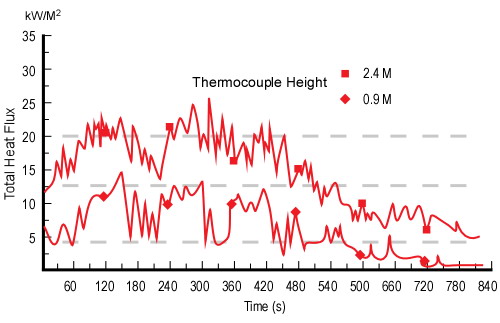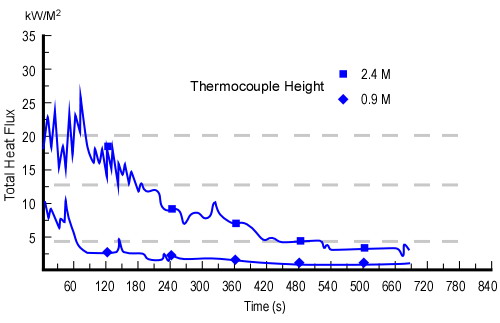Shielded Fires Part 2
Thursday, February 12th, 2009The previous post (Shielded Fires) examined US Navy research on the effectiveness of different nozzle techniques when dealing with shielded fires conducted on the ex-USS Shadwell, the US Navy full scale damage control research facility (see Figure 1).
Figure 1. USS Shadwell
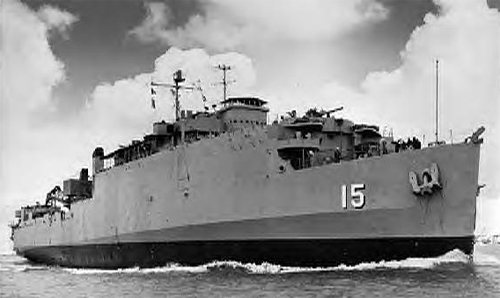
The researchers tested two different methods for controlling flaming combustion overhead while moving from the entry point to a location in a compartment where firefighters could make a direct attack on the seat of the fire. The first method involved use of a straight stream or narrow fog pattern and the second involved the use of a medium (60o) fog pattern directed upward at a 45o angle. In both cases, one to three second pulses were used in application of water into the hot gas layer.
US Navy Findings
Analysis of this series of tests resulted in identification of a number of specific findings related to tactics, equipment, and training. Three of these findings were particularly relevant to the differences between straight stream/narrow fog and medium fog applied to control flaming combustion in the upper layer.
- Pulsed application with a medium fog pattern directed upward at a 45o angle resulted in less disruption of the thermal layer than use of a straight stream/narrow fog pattern.
- Use of a straight stream/narrow fog resulted in production of a large amount of steam. This was attributed to the fact that the hose streams had to be deflected compartment linings.
- Water management is important when controlling fire in the upper layer, particularly when using a straight stream/narrow fog. Excess water will only result in excess steam production.
Discussing the findings, the researchers observed that pulsed application of medium fog appeared to be an effective tactic for controlling flaming combustion in the upper layer. This conclusion is supported by consistent reduction of upper layer temperature over the course of the tests involving use of pulsed application of a medium fog pattern. Previous concerns that this approach would result disruption of thermal layering and excess steam production appeared to be unfounded. This conclusion is supported by the heat flux data at 0.9 M (7′ 10″) and 2.9 M (3′) above the floor. Disruption of thermal layering is indicated by an upward spike in lower level heat flux or equalization of heat flux at the lower and upper levels.
Questions
Several questions about the outcome of these tests were posed at the end of the Shielded Fires post.
- Why did the application of water in a straight stream/narrow fog pattern fail to effectively control flaming combustion in the upper layer?
- Why did the upper layer temperature fluctuate when a straight stream/narrow fog was used?
- Why did the upper layer temperature drop consistently when a medium angle fog pattern was used?
- How did the heat flux measurements correlate with the upper layer temperatures in these two tests?
- What are the implications of the heat flux data recorded during these tests on tenability within the compartment for both firefighters and unprotected occupants?
Water converted to steam on contact with compartment linings or other hot objects cools the surfaces. This indirectly lowers gas layer temperature as the hot gases will continue to transfer heat to compartment linings and other cooler objects in an attempt to equalize temperature. However, the effect on upper layer temperature is limited, minimizing effectiveness of stream application in controlling flaming combustion in the upper layer. In addition, as gas temperature is not significantly reduced, steam produced on contact with hot surfaces is added to the volume of hot gases, resulting in a less tenable environment.
Ineffectiveness of straight stream/narrow fog attack in controlling flaming combustion in the upper layer and the perception of increased steam production with this type of attack likely have a common cause. Conversion of water to steam requires much more energy than simply heating water from ambient temperature to its boiling point. When water changes phase from liquid to gas (steam) while in the hot gas layer, the temperature of the gases is reduced. This has several consequences. First, sufficient reduction in temperature results in extinguishment of flaming combustion. Second, reduction of gas layer temperature causes a proportional reduction in gas volume. As illustrated in Figure 2, if 35% of the water is truned to steam in the hot gas layer, the total volume of steam and hot fire gases is less than the original volume of hot fire gases alone (Särdqvist, 2002). As this is often difficult to understand, I will provide a more detailed explanation of this in a subsequent post.
Figure 2. Gas Temperature and Relative Volume
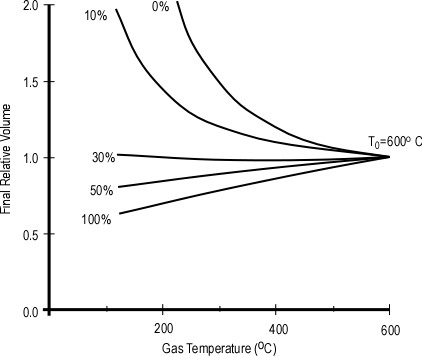
Note. Adapted from Water and Other Extinguishing Agents (p. 155) by Stefan Särdqvist, 2002, Karlstad, Sweden: Raddningsverket. Copyright 2002 by Stefan Särdqvist and the Swedish Rescue Services Agency.
Production of the same volume of steam can have far different consequences depending on where it is produced (in the hot gas layer versus on contact with hot surfaces!
Total heat flux includes energy transferred through radiation, convection, and conduction. However, in these full scale fire tests, radiant and convective heat transfer was most significant. Radiant heat transfer is dependent on the temperature of upper layer gases and flaming combustion. Convective heat transfer is dependent on gas temperature, movement of hot gases, and moisture. Reduction in upper layer temperature while maintaining thermal layering minimizes total heat flux at the lower level where firefighters are working.
Other Considerations
These tests were conducted on a ship (see Figure 1) with most of the compartment linings being metal (rather than gypsum board, plaster, or wood as typically encountered in buildings. The fire compartment did not have windows or other ventilation openings that may exist in more typical buildings encountered by structural firefighters. These differences are significant, but do not diminish the importance of the results of these tests and findings by the researchers.
These tests provide substantive evidence in support of the effectiveness of water converted to steam in the hot gas layer (as opposed to on surfaces) in controlling flaming combustion in the hot gas layer. However, this does not diminish the importance of direct application of water onto burning fuel in a direct attack to complete the process of extinguishment.
Reference
Särdqvist, S. (2002). Water and other extinguishing agents. Karlstad, Sweden: Swedish Rescue Services Agency.
Scheffey, J., Siegmann, C., Toomey, T., Williams, F., & Farley J. (1997) 1994 Attack Team Workshop: Phase II-Full Scale Offensive Fog Attack Tests, NRL/MR/6180-97-7944. Washington, DC: United States Navy, Naval Sea Systems Command
Remember the Past
In Myth of the Self-Vented Fire I pointed out that every week represents the anniversary of the death of one or more firefighters as a result of extreme fire behavior. Some firefighters have heard about these incidents, but many have not. In an ongoing effort to encourage us to remember the lessons of the past and continue our study of fire behavior, I will occasionally be including brief narratives and links to NIOSH Death in the Line of Duty reports and other documentation in my posts.
February 11, 1998 – 1030
Firefighter Paramedic Patrick Joseph King
Firefighter Anthony E. Lockhart
Chicago Fire Department, Illinois
Firefighter King and Firefighter Lockhart responded on different companies to a report of a structural fire in a tire shop. No visible fire was encountered, there was no excessive heat, and only light smoke was found in most of the building with heavier smoke in the shop area. Ten firefighters were in the interior of the structure when an event that has been described as a flashover or backdraft occurred. The firefighters were disoriented by the effects of the backdraft. Some were able to escape but Firefighter King and Firefighter Lockhart were trapped in the structure. A garage door that self-operated due to fire exposure may have introduced oxygen into the fire area and may have been a factor in the backdraft. The exit efforts of firefighters were complicated by congestion in the building. Within minutes of the backdraft, the building was completely involved in fire and rescue efforts were impossible. Both firefighters died from carbon monoxide poisoning due to inhalation of smoke and soot. Further information related to this incident can be found in NIOSH Fire Fighter Fatality Investigation 98-F-05.
February 9, 2007
Firefighter-Paramedic Apprentice Racheal Michelle Wilson
Baltimore City Fire Department, Maryland
Firefighter Wilson and the members of her fire academy class were attending a live fire training exercise in a vacant rowhouse in Baltimore.
Firefighter Wilson was assigned to a group of apprentices and an instructor designated as Engine 1. Her group advanced a dry attack line into the structure. As they climbed the stairs, the line was charged. Engine 1 encountered and extinguished fire on the second floor but did not check the rest of the second floor for fire prior to proceeding to the third floor. On the third floor, they again encountered and began to extinguish fire.
Fire conditions began to worsen with a marked increase in smoke and heat that appeared to be coming from the second floor. Engine 1 firefighters who were on the stairs began to receive burns from the fire conditions. The instructor for Engine 1 climbed out a window at the top of the stairs and helped one burned firefighter escape to the roof.
Firefighter Wilson appeared at the window in obvious distress and attempted to escape. The windowsill was unusually high (41 inches) and she was unable to escape. Firefighter Wilson momentarily moved away from the window, at which time she advised other firefighters to go down the stairs to escape. When she returned to the window, her SCBA facepiece was off and she was beginning to receive burns. She was able to get her upper body out of the window but she could not make it through. Firefighters on the exterior were unable to pull her through until firefighters were able to gain access on the interior and assist with the effort.
When Firefighter Wilson was pulled to the roof, she was in full cardiac and respiratory arrest. She was immediately removed from the roof and received advanced life support care and transportation to the hospital. She was pronounced dead at 1250 hours. Firefighter Wilson received total body surface burns of 50 percent. The cause of death was listed as thermal burns and asphyxiation.
Further information related to this incident can be found in NIOSH Firefighter Fatality Investigation F2007-09 and the Independent Investigation Report on the Baltimore City Fire Department Live Fire Training Exercise, 145 South Calverton Road, February 9, 2007.
My next post will examine the incident in which Rachael Wilson lost her life in greater detail.
Ed Hartin, MS, EFO, MIFIreE, CFO




